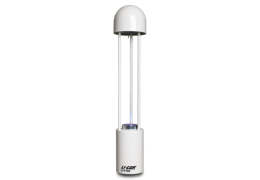Tips for success
Vibrations
The LI-7700 may be sensitive to vibration at certain high frequencies, which could affect the measurements. These frequencies are not typically experienced in tower mount applications. For land-based installations, one the most likely sources of vibrational problems would be a tower with excessively tight guy wires. For other settings where there may be vibrations in a problematic range, you should try to minimize vibration through alternative mounting attachments.
Grounding
The power supply, Ethernet, and analog inputs are all electrically isolated from each other and from the internal circuitry. There also are protection clamps in the form of spark gaps on the isolated circuits to the instrument chassis. For lightning protection, make sure the mounting structure for the instrument is electrically grounded, or run an independent bonding wire from the instrument mount to the earth.
The LI-7700 methane analyzer presents some unique challenges to the measurement system design relative to power system design. This paper describes those challenges, and presents a mitigation strategy for the power system.
Problem
The LI-7700 has a number of environmental mitigation features that are designed to ensure maximum measurement data quality, while minimizing overall power consumption. These features include the spin motor, top mirror heater, bottom mirror heater, and cleaning fluid pump. These features are under software control and are configured by the user to optimize power consumption and cleaning fluid use for a particular operating environment. The primary purpose of the environmental mitigation features is to combat the effects of contamination and water vapor condensation on the mirror surfaces.
The overall power consumption of the analyzer is directly affected by the configuration of the environmental mitigation features. Certain combinations of features can produce short duration power consumption that is up to 10 times the normal consumption rate. In addition, the highest loads are often encountered at cold temperatures, where the power delivery system is likely to be stressed for other reasons. Therefore, it is important to consider the peak load when designing a power delivery system for the LI-7700.
Recommendations
The LI-7700 is designed to operate on a DC power bus from 9 to 35 volts DC. The analyzer was designed with efficient DC/DC switching regulators, and thus operates at nearly constant input power regardless of input voltage. Therefore, for a given demand condition, power supply input current will be twice as high at 12 volts than at 24 volts (for example). It follows that demand peaks can be up to 9.5A for the combination of lowest operating voltage and highest power demand. To make matters worse, peak power demand will often coincide with the weakest portion of the typical power system’s operating point (very low ambient temps, low light levels (for solar), and thus, low system voltage).
For systems operated at routinely cold temperatures and high ambient relative humidity, it is preferable to use a 24 volt supply system. This ensures that the peak demand from the LI-7700 can be serviced using standard LI-COR power cable assemblies. In the event that 24 volt power is not available, then 12 volt power can be used with some consideration to the power cabling servicing the instrument. For the 12 volt, cold temperature configuration, the standard LI-COR cable should be cut to less than 1 meter in length, and spliced onto a power cable of AWG #10 (5 sq. mm) or larger. Ensure that both conductors positive and both conductors negative are spliced to the corresponding conductor on the larger cable. Under these conditions, the fuse in the LI-7700 should be upgraded to an 8A fuse (Littelfuse P/N 37318000410).
Frequently asked questions
Q. I have a 12 volt system operating my LI-7700 right now. I am just using the standard LI-COR power cable. What will happen when it gets cold outside?
A. As the temperature drops, power demand for various components will gradually increase. At some point, the voltage drop in the power cable will become large enough to cause occasional dropouts in the instruments power supply, which could result in erratic operation and data loss. The instrument will recover when the power demand reduces, or the power system voltage increases.
Q. What is magic about AWG #10? Can I use something else?
A. Yes. The goal is to reduce the total voltage drop in the cable (both power and ground) to less than 1.0 volts. AWG #10 will be adequate up to 14 meters of cable length.
Q. Why is the smaller cable OK in a 24 volt system?
A. In a 24 volt lead-acid battery system, the minimum voltage is 21 volts. Peak demand at 21 volts is just over 3.8 amps, resulting in a peak voltage drop of 0.6 volts. The power supply cabling will not be a factor in this configuration.
